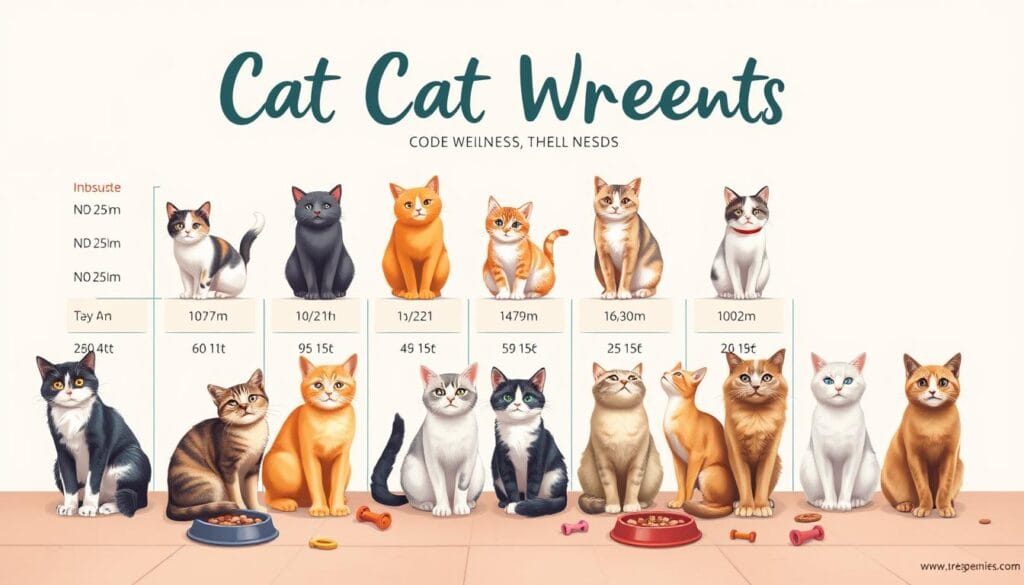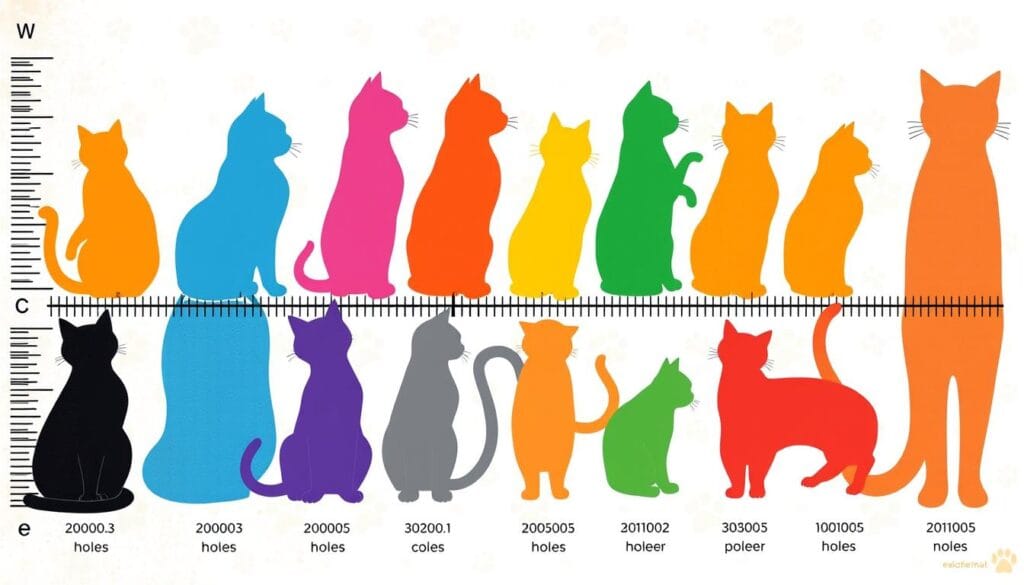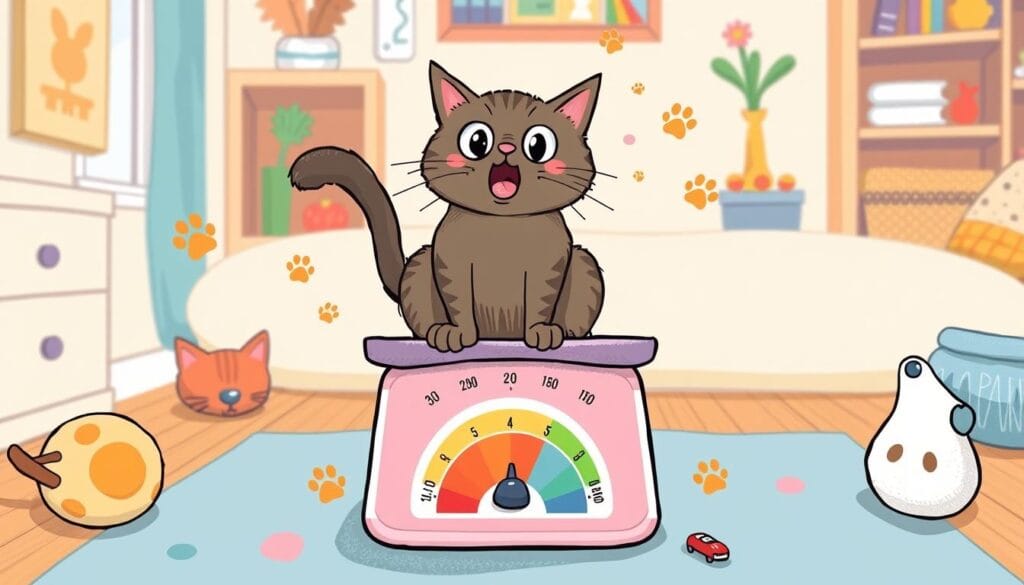Keeping your cat at a healthy weight is key for their happiness and health. Sadly, the Morris Animal Foundation says 61% of cats are too heavy. Being overweight can cause serious health problems like diabetes and cancer in cats.
This article will guide you on how to check if your cat is overweight. We’ll show you how to make sure they stay healthy.
Key Takeaways
- Obesity is a growing health crisis among domestic cats, with 61% of felines being overweight or obese.
- Maintaining a healthy weight is crucial for your cat’s well-being, as excess weight can lead to a host of serious health issues.
- This article will provide tools and information to help you assess your cat’s weight status and take appropriate action to ensure they stay within a healthy range.
- Understanding your cat’s breed-specific weight ranges and using the overweight cat chart can help you determine if your feline friend is carrying extra weight.
- Consulting with your veterinarian is recommended to develop an effective weight management plan for your cat if they are overweight or obese.
Understanding Feline Obesity: A Growing Health Crisis
Feline obesity is a big problem, with 61% of cats in the US being overweight or obese. This is a major threat to the health and well-being of our cats.
Extra weight can greatly affect a cat’s health. Just a few ounces over the healthy cat weight can harm their vitality and quality of life. Overweight cats are at higher risk for diabetes, arthritis, urinary tract infections, joint pain, chronic inflammation, and skin problems.
The main cause of feline obesity is an imbalance between calories eaten and energy burned. Cats gain weight when they eat more calories than they use. Factors like neutering, getting older, and less exercise in indoor cats also play a role in the obesity epidemic.
“Wild carnivores such as lions, cheetahs, tigers, leopards, and panthers are rarely seen as obese, highlighting the natural balance in their diet and lifestyle.”
It’s important to recognize the signs of weight gain in cats, like trouble jumping and not feeling their ribs easily. Regular vet visits can help keep a cat’s healthy cat weight in check and catch any problems early. This allows for timely action and an effective pet weight management plan.
By understanding the causes and effects of feline obesity, pet owners can take steps to keep their cats healthy. Working with vets is key to creating a pet weight management plan that meets each cat’s needs.
How to Use the Overweight Cat Chart
Keeping your cat at a healthy weight is key for their happiness and health. The Body Condition Score (BCS) system is a great tool to check your cat’s weight. It helps you find the right ways to manage their weight.
Body Condition Score Explained
The BCS scores cats from 1 to 9. A score of 1 means they are very underweight, and 9 means they are very overweight. A healthy cat should score between 4 and 5. This means they have a thin layer of fat and a clear waistline when seen from above.
Visual Assessment Guidelines
- Look for an obvious waistline when viewed from above.
- Observe a slight abdominal tuck when viewed from the side.
- Feel for a thin layer of fat covering the ribs, which should be easily palpable.
Understanding Weight Distribution
A healthy cat should have even weight distribution. Their ribs should be easy to feel, with no extra fat around the belly or other areas. The belly fat should be about the size of a kiwi fruit.
| Body Condition Score | Description | Ideal Weight Range |
|---|---|---|
| 1-3 | Underweight | 2.5 – 4 kg |
| 4-5 | Ideal | 4 – 5.5 kg |
| 6-9 | Overweight/Obese | 5.5 – 7 kg |
It’s important to regularly check your cat’s body condition and weight. This keeps them healthy and happy. Using the overweight cat chart helps spot any weight problems. It also guides you on how to use cat body condition scoring and overweight cat treatment effectively.
Ideal Weight Ranges for Different Cat Breeds
Keeping your cat at a healthy weight is key for their happiness and health. But, the right weight can differ based on the breed. Knowing the specific weight ranges for your cat’s breed helps keep them at a cat weight tracker that supports their healthy cat weight.
| Cat Breed | Healthy Weight Range (lbs) |
|---|---|
| Domestic Shorthair | 6 – 12 |
| Persian | 7 – 14 |
| Devon Rex | 6 – 9 |
| Sphynx | 6 – 12 |
| American Shorthair | 7 – 12 |
| Munchkin | 4 – 9 |
| British Shorthair | 9 – 18 |
| Maine Coon | 8 – 20 |
Remember, a cat’s gender can also affect their ideal weight. Males are usually bigger and heavier than females. Also, spayed or neutered cats might gain weight faster and need special diets to stay at a healthy cat weight.
“The majority of cats typically fall within the ideal weight range of 8-12 pounds, with exceptions like Maine Coon cats that tend to be larger in size.”
By knowing the cat weight tracker for your breed, you can team up with your vet. This ensures your cat stays healthy and avoids obesity risks.

Signs Your Cat Is Carrying Extra Weight
As a responsible pet owner, it’s important to watch your cat’s weight closely. Overweight cats are at higher risk for serious health problems. These include arthritis, urinary tract infections, diabetes, and more. Recognizing the signs of extra weight helps you take action to keep your cat healthy.
Physical Indicators
One clear sign of an overweight cat is not seeing a waistline from above. Also, if you can’t feel your cat’s ribs, they might be too heavy. A rounder face is another sign of extra weight.
Behavioral Changes
Behavioral changes can also show if your cat is overweight. Overweight cats often play less and climb less. If your cat is struggling to jump or gets tired easily, they might be overweight.
Movement Limitations
Difficulty moving is another sign of extra weight. Cats that have trouble jumping or climbing stairs might be overweight. Use the overweight cat chart to check your cat’s body condition and see if they need a weight management plan.
Watching your cat’s weight and noticing these signs can help you catch issues early. By taking action, you can work with your vet to tackle feline obesity. This ensures your cat stays healthy and active.

How to Weigh Your Cat at Home
It’s important to keep an eye on your cat’s weight for their health. Regular weigh-ins can help spot any weight issues early. You can weigh your cat at home with a simple method.
To do this, use a bathroom scale. First, weigh yourself with your cat, then alone. The difference is your cat’s weight. Or, use a digital luggage scale with a carrier. Just weigh your cat in the carrier, then the empty carrier, and subtract.
It’s key to keep a log of your cat’s weight. This lets you see how they’re doing over time. By watching their weight, you can keep them healthy and act if needed.

If you’re worried about your cat’s weight or health, talk to your vet. They can give advice tailored to your cat’s needs. This helps keep your cat at a healthy weight and lifestyle.
| Ideal Weight Range for Cats | Weight Loss Guidelines |
|---|---|
|
|
Health Complications of Feline Obesity
Feline obesity is a big problem, affecting up to 63% of cats in developed countries. Overweight or obese cats face many health risks. These risks can greatly affect their quality of life.
Immediate Health Risks
Obesity in cats can cause diabetes, arthritis, and urinary tract infections. These issues can make cats uncomfortable, in pain, and less mobile. It’s hard for them to do their natural behaviors and activities.
Long-term Medical Conditions
Long-term obesity can lead to serious health problems. These include pancreatitis, kidney disease, liver disease, and hepatic lipidosis. These severe conditions can harm a cat’s health and well-being for a long time.
Impact on Quality of Life
Obesity can shorten a cat’s life by up to five years. It also limits their mobility and comfort. This makes it hard for them to enjoy their natural behaviors and live a good life.
It’s important to address feline obesity to keep your cat healthy. Understanding the risks helps you take steps to support your cat’s optimal weight and well-being.
Creating an Effective Weight Loss Plan
Starting a cat diet plan or pet weight management journey needs a smart plan. First, talk to your vet to make a weight loss plan for your cat. They’ll use your cat’s age, health, and activity to guide you.
Begin by keeping a food log for your cat. This helps figure out the right calories and portions for weight loss. Aim to lose 4-6% of your cat’s body weight each month.
- Work with your vet to set a weight loss goal and timeline.
- Think about your cat’s age, health, and activity when planning.
- Check in regularly and adjust the plan as needed.
A good cat diet plan and pet weight management program needs teamwork. With patience, consistency, and a plan made just for your cat, they can get to a healthier weight. This will improve their life quality.
“Achieving a healthy weight for your cat is a journey, not a destination. With the right support and guidance, you can help your beloved pet reach their optimal weight and enjoy a longer, happier life.”
Diet Modifications for Overweight Cats
Helping your cat reach a healthy cat weight starts with diet changes. Choose wet food for its high protein and water content. Use dry food sparingly, as treats or in small amounts.
Ask your vet about special weight management foods. These are made to help your cat lose weight safely.
Wet vs Dry Food Options
Wet food is best for overweight cats because it keeps them hydrated and is protein-rich. Dry food, with its carbs and calories, can lead to overeating. Make wet food the main part of your cat’s diet, and dry food a rare treat.
Portion Control Guidelines
Controlling portions is key for your cat’s weight loss. Use measuring scoops for the right amount based on your cat’s size and activity. Don’t let them eat all day, as it can cause overeating.
Treating Without Overfeeding
Treats can help with weight management, but give them carefully. Treats should not make up more than 10% of your cat’s daily calories. Choose low-calorie, high-protein treats to support their weight loss.
By making these diet changes, you can help your cat reach a healthy cat weight. This will improve their health and happiness. Always talk to your vet to create a cat diet plan that fits your cat’s needs.
Exercise and Activity Solutions for Weight Loss
Getting your overweight cat to exercise can be tough, but it’s crucial for their health. Try to add at least 20 minutes of activity to their daily routine. Use interactive toys like laser pointers or tossed toys to get them moving.
Offer climbing spots with cat trees or wall shelves to keep them active. Introducing new objects like boxes or paper bags can spark their curiosity. Food puzzles are also a great way to mix mental and physical activity, as they have to work for their treats.
- Engage your cat in at least 20 minutes of interactive play daily
- Provide climbing structures like cat trees or wall shelves
- Introduce novel objects like boxes and bags to encourage exploration
- Utilize food puzzles to combine mental and physical stimulation
Remember, cat exercise routines and overweight cat treatment need to fit your cat’s unique needs. Begin slowly, watch their progress, and be patient. With the right steps, you can help your cat lose weight safely and effectively.
| Activity | Benefits | Tips |
|---|---|---|
| Laser Pointer | Promotes chasing and jumping | Avoid shining the laser in your cat’s eyes |
| Tossed Toys | Encourages running and pouncing | Choose toys that are safe and easy to grip |
| Cat Trees | Provides climbing and scratching opportunities | Ensure the tree is sturdy and appropriately sized |
| Food Puzzles | Combines mental and physical stimulation | Start with easy puzzles and gradually increase difficulty |
“Encouraging your cat’s natural curiosity and activity levels is key to supporting their weight loss journey.”
Conclusion
Keeping your cat at the right weight is crucial for their health and long life. Using the overweight cat chart regularly is key. It helps with a balanced diet, exercise, and vet advice. This ensures your cat stays healthy.
Slow and steady weight management is important. It helps avoid serious health issues linked to being overweight or obese.
Being informed and proactive helps your cat stay at a healthy cat weight. Monitor their weight, adjust their diet and activity, and work with your vet. This keeps your cat healthy and full of life for many years.
Your cat’s weight shows their overall health. By focusing on their health, you can make sure they live a long, happy life with you.

